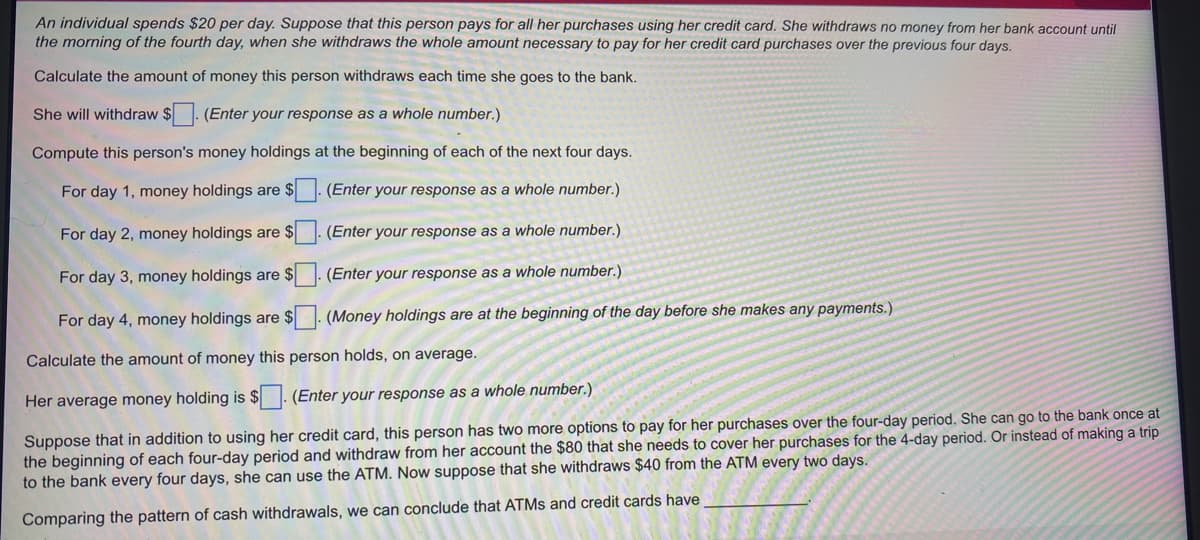An individual spends $20 per day. Suppose that this person pays for all her purchases using her credit card. She withdraws no money from her bank account until the morning of the fourth day, when she withdraws the whole amount necessary to pay for her credit card purchases over the previous four days. Calculate the amount of money this person withdraws each time she goes to the bank. She will withdraw $. (Enter your response as a whole number.) Compute this person's money holdings at the beginning of each of the next four days. For day 1, money holdings are $. (Enter your response as a whole number.) For day 2, money holdings are $. (Enter your response as a whole number.) For day 3, money holdings are $. (Enter your response as a whole number.) For day 4, money holdings are $. (Money holdings are at the beginning of the day before she makes any payments.) Calculate the amount of money this person holds, on average. Her average money holding is $ . (Enter your response as a whole number.) Suppose that in addition to using her credit card, this person has two more options to pay for her purchases over the four-day period. She can go to the bank once at the beginning of each four-day period and withdraw from her account the $80 that she needs to cover her purchases for the 4-day period. Or instead of making a trip to the bank every four days, she can use the ATM. Now suppose that she withdraws $40 from the ATM every two days. Comparing the pattern of cash withdrawals, we can conclude that ATMS and credit cards have
An individual spends $20 per day. Suppose that this person pays for all her purchases using her credit card. She withdraws no money from her bank account until the morning of the fourth day, when she withdraws the whole amount necessary to pay for her credit card purchases over the previous four days. Calculate the amount of money this person withdraws each time she goes to the bank. She will withdraw $. (Enter your response as a whole number.) Compute this person's money holdings at the beginning of each of the next four days. For day 1, money holdings are $. (Enter your response as a whole number.) For day 2, money holdings are $. (Enter your response as a whole number.) For day 3, money holdings are $. (Enter your response as a whole number.) For day 4, money holdings are $. (Money holdings are at the beginning of the day before she makes any payments.) Calculate the amount of money this person holds, on average. Her average money holding is $ . (Enter your response as a whole number.) Suppose that in addition to using her credit card, this person has two more options to pay for her purchases over the four-day period. She can go to the bank once at the beginning of each four-day period and withdraw from her account the $80 that she needs to cover her purchases for the 4-day period. Or instead of making a trip to the bank every four days, she can use the ATM. Now suppose that she withdraws $40 from the ATM every two days. Comparing the pattern of cash withdrawals, we can conclude that ATMS and credit cards have
Chapter5: Managing Checking And Savings Accounts
Section: Chapter Questions
Problem 1FPC
Related questions
Question
An individual spends $20 per day. Suppose that this person pays for all her purchases using her credit card. She withdraws no money from her bank account until
the morning of the fourth day, when she withdraws the whole amount necessary to pay for her credit card purchases over the previous four days.

Transcribed Image Text:An individual spends $20 per day. Suppose that this person pays for all her purchases using her credit card. She withdraws no money from her bank account until
the morning of the fourth day, when she withdraws the whole amount necessary to pay for her credit card purchases over the previous four days.
Calculate the amount of money this person withdraws each time she goes to the bank.
She will withdraw $. (Enter your response as a whole number.)
Compute this person's money holdings at the beginning of each of the next four days.
For day 1, money holdings are $
(Enter your response as a whole number.)
For day 2, money holdings are $
(Enter your response as a whole number.)
For day 3, money holdings are $
(Enter your response as a whole number.)
For day 4, money holdings are $. (Money holdings are at the beginning of the day before she makes any payments.)
Calculate the amount of money this person holds, on average.
Her average money holding is $ . (Enter your response as a whole number.)
Suppose that in addition to using her credit card, this person has two more options to pay for her purchases over the four-day period. She can go to the bank once at
the beginning of each four-day period and withdraw from her account the $80 that she needs to cover her purchases for the 4-day period. Or instead of making a trip
to the bank every four days, she can use the ATM. Now suppose that she withdraws $40 from the ATM every two days.
Comparing the pattern of cash withdrawals, we can conclude that ATMS and credit cards have
Expert Solution
This question has been solved!
Explore an expertly crafted, step-by-step solution for a thorough understanding of key concepts.
This is a popular solution!
Trending now
This is a popular solution!
Step by step
Solved in 3 steps

Knowledge Booster
Learn more about
Need a deep-dive on the concept behind this application? Look no further. Learn more about this topic, finance and related others by exploring similar questions and additional content below.Recommended textbooks for you



